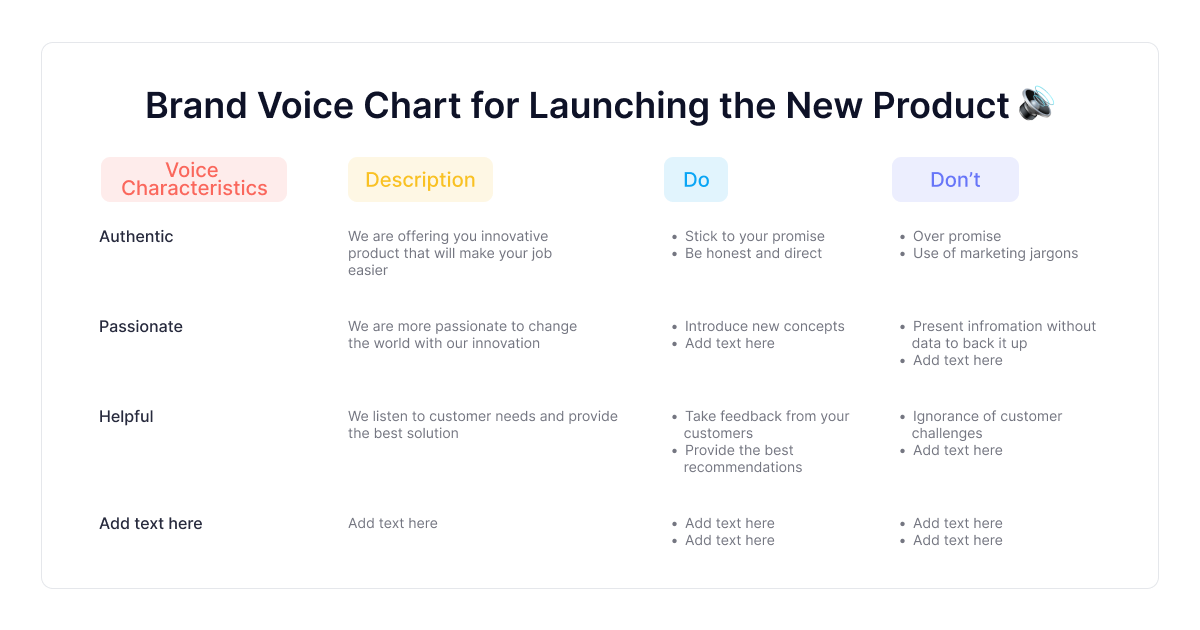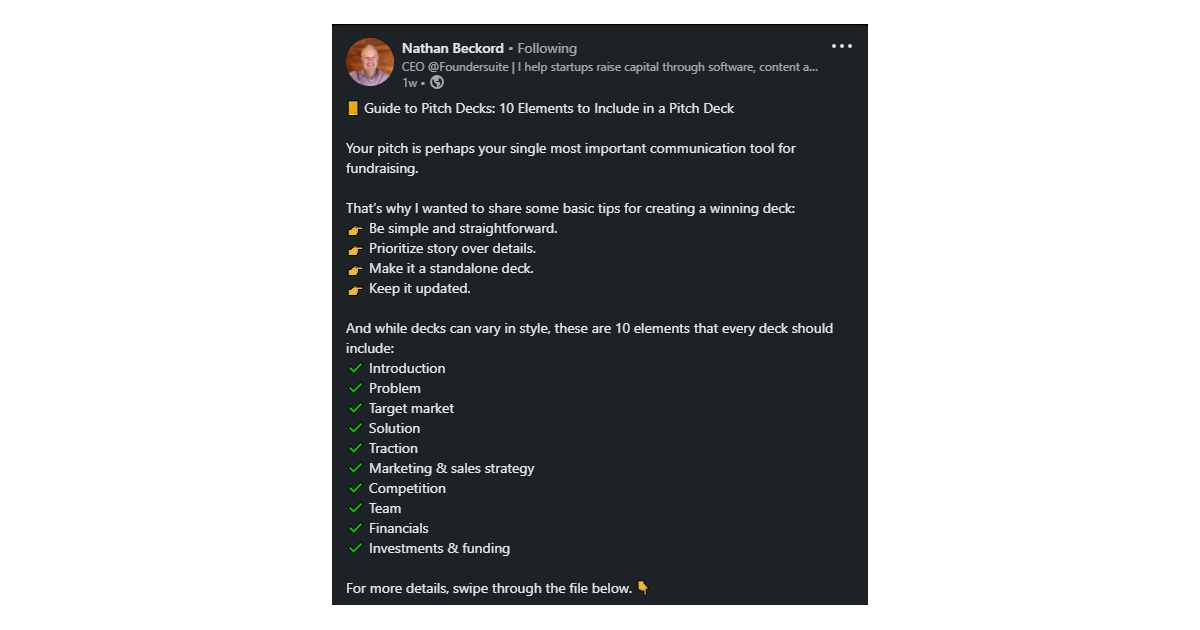Making your social media posts stand out nowadays can be a difficult task.
Your audience is bombarded with hundreds of headlines and images everyday, so you need to make sure yours get noticed and remembered.
It turns out that's not really the case.
Have you ever asked yourself "How can I improve my social media copies so that people actually take action"?
There are so many variables that it's difficult to name them all.
To get your point across in the most effective way, you'll need to know how human psychology works, what works and what doesn't from a marketing perspective.
And yes – even how to correctly use grammar.
Well, have no fear because I've got a list full of nuggets here just for you.
I will show you the top 9 copywriting tips for social media that will help you charm your audience by creating copies that work on almost any platform.
So let’s get straight to it.
1. Create a Brand Voice and Tone Guide
Compared to a blog post or landing page, writing for social media is a different game that requires different skills, but ones that can easily be learned with practice.
How can your brand and social media channel be recognizable?
Let me tell you that many companies are making the same mistake here — wandering in the digital world without knowing what their brand represents.
So, how to change this?
Before you start writing anything, first, you should create a brand voice and tone guide.
The voice and tone guide is the backbone of any good copywriting strategy.
It’s all about establishing what you stand for, how you talk, and how you want to be perceived by your audience.
It helps you keep your content consistent across all platforms and ensure your message gets across clearly.
Here’s an example of how it looks for launching a new product:

So is your brand or product friendly, reliable, trustworthy?
Write down the specific examples of how this perception will be conveyed through all forms of content creation, including social media posts, blog articles, case studies, and so on.
Here are some questions that can help you with this process:
- What does your company sound like?
- Do you use slang or technical language?
- Do you have a sense of humor?
- How do you respond to criticism?
- Are there specific topics you avoid discussing altogether?
- What kind of language do your customers use when interacting with you online?
Answering these questions, and noting them down will help you be clear about how you want to present your brand online.
By sticking to it within your every post will help you be recognized within your audience, and will help you build a strong relationship with them online.
2. Ask Open-Ended Questions
We use social media to communicate with friends and family, but we also use it as a platform to market our businesses.
The fact is that people are more likely to respond to social media posts that engage them.
How?
One great way to do this is by asking your audience an open-ended questions.
Open questions are effective in gaining attention because they require a response from the reader.
Since people naturally love to talk about themselves, answering a question allows them to do just that.
What’s more, these kind of questions cause people to think about their answers before they give them.
Which makes a great step for getting their attention, right?

Here are some examples of open questions that you can use in your social media content writing:
- What are your favorite brands/companies in [specific niche]?
- What do you like most about [product or service]?
- How will you be using [product or service]?
- What would your ideal solution be like?
What’s great about open-ended questions is that they can help you build relationships and make people feel more connected to your brand.
But be careful not to cross the line into “too much information” territory — these questions can feel invasive or even offensive if not done right.
3. Write Your Draft, Then Rewrite It
When writing posts for your social media channels, you can't expect everything to be great at first sight.
That's why it takes some time to plan.
And drafts are a great way to note down everything you want to mention within your posts.
But before starting with a draft, think about the emotions you want to evoke.
This powerful technique will help you navigate your writing and make your readers feel exactly what you want them to feel while reading your posts.
If you want people to feel happy, use words that make people feel happy, such as “glad” and “pleased” instead of “annoyed” or “angry.”
If you want people to feel sad or guilty after reading your post, use words that evoke those emotions, such as “sorry” or “regretful.”
When you’re done with the emotional words, write your thoughts in a rough draft
Don't worry about grammar, spelling, or punctuation when you're first jotting down ideas for your post.
Now, read through the rough draft and arrange your content into an outline or storyboard format.
You'll have a sense of what needs to be included and in what order it should be presented.
This might mean rewriting entire sections or choosing different supporting details based on their relevance to your main point.
Rework the rough draft until it flows smoothly and makes sense to you (and hopefully others).
Pro tip: One easy way you can use to structure your thoughts into a whole post is by using TextCortex Chrome Extension to rewrite your sentrences from draft.
Just write your thoughts, highlight them, and hit “Rewrite” button.
It will help you transform your ideas into thoughtful and easy-to-read sentences that engage your readers.
And not only that.
It can also create the whole post instead of you.
Just, enter the topic consisting of few main keywords, highlight them, and hit the “Long-form post” button.
Voila!
The whole post in only a couple of seconds.
4. Don’t Be Afraid of Using Humor
It's easy to think that you have to be completely serious and professional when writing for social media.
Humor is an effective way to connect with your audience, but many companies are afraid to use it because they think it might not be taken seriously.
The truth is that people love humor – especially when it comes from brands they trust and respect.
Using a bit of humor within your posts can make your copy more unique and memorable and help you connect with your audience in a more natural way.

However, humor can also backfire if you don't know what you're doing.
Here are some tips to keep in mind when using humor in your marketing efforts:
- Don't force it - If the joke doesn't fit naturally into the context of your post, then don't use it. If the joke feels forced, it will come across as cheesy and awkward, which is exactly what you don't want when people are reading your posts.
- Don't listen what others say - Some writers are afraid to use humor because they worry about coming across as unprofessional or silly — but this shouldn't stop anyone from using humor if it fits naturally with their content.
5. Avoid Writing Big Blocks of Text
When writing sentences and paragraphs for social media posts, it's essential to make sure they are easy to read.
People usually don't have much time on social media, so they're unlikely to read lengthy posts or watch lengthy videos.
You want your readers to be able to read your content quickly, without having to scroll much down the page.

One of the most effective ways to do that is to keep the text short, simple and easily digestible by breaking them into short paragraphs.
Here’s how to effectively do that:
- Use short sentences - Keep one idea per sentence.
- Keep your sentence structure as simple as possible - Don’t use complicated language that might alienate your readers — especially if they're not native English speakers.
- Don't try to be too clever with your words - Make your post be easy to understand by a 5 year old.
You want your audience to understand what you're saying straight away, so keep things simple and clear whenever possible.
6. Always Use Bullet Points for Easy Reading
Social media posts are usually quick and easy to read, but your content can get lost in the noise if you don’t structure it well.
Especially if those are the long-form posts that strive to provide more value to your audience.
By breaking up longer paragraphs into bullets or numbered lists, you can help readers scan your post more easily for key points that may be useful to them.
This makes it easy for their eyes to move from one point to the next without having to read a lot of words between each point.

So, even if you have a lot of information to share, try breaking it up into shorter paragraphs with subheads and graphics whenever possible.
Note: For the best reading experience, make sure that each bullet point is no more than five or six words long.
7. Test Different Writing Frameworks
The best way to get started with social media copywriting is to have a strategy before you begin.
For example, instead of just saying "buy this product," you should explain why people need it and how it can solve their problems.
And the way to achieve exactly that is by using specific framework that will make your sales pitch stand out.
This way, your readers will see the value in what you're offering them.
There are a few different frameworks for copywriting that can help you come up with ideas for your social media posts.
Here are two of the most popular ones you can use:
1. AIDA - stands for Attention, Interest, Desire and Action.
When using this framework, your goal is to first grab your readers' attention by askingsuch as a question or writing a controversial statement.
Then pique their interest by providing more information in the body of the post.
And finally move them into taking some sort of action — whether that's subscribing to your newsletter or downloading your ebook.
2. PAS - A framework that stands for Problem, Agitate and Solution.
Using this framework you want to start with identifying a problem that affects people who can use your product or service (for example, "I hate cooking").
Then you need to agitate them with something as "You're not alone, we got a microwave for you".
Finally, provide solution by telling them how great it feels to have solved their problem (such as "Now I don't have this problem anymore.”
Using these frameworks and making them part of your writing can really transform your business and make your audience be your greatest fans.
8. Tell Stories
Stories are one of the oldest forms of communication, and still work today because they're so powerful at making an emotional connection with your audience.
As Ann Handley writes in her book, "Everybody Writes":
"Stories are much more effective than facts and figures at communicating information."
"They make us feel something.”
“They evoke emotion.”
“They draw us in."
So, if you want to sell more products or services online, learn how to tell stories that connect with your target audience in a meaningful way.
Then share those stories on social media platforms like Facebook, Twitter, or LinkedIn.
The more emotional resonance your story has with your target audience, the more likely they'll be interested in buying from you.

Also, what you can do to support your stories is to use visuals.
Visuals will help you tell better stories on social media because they give people something to hold onto when you're finished telling them.
According to an analysis by BuzzSumo, posts that include photos have 2.3 times better engagement rate than those without photos.
You can tell stories by sharing anecdotes or personal experiences related to your business or by sharing facts and figures demonstrating how great your products or services are at making people happy (or whatever else matters to them).
If you want to go big with this tactic, try using a fictional character or storyline as a way to engage your audience more deeply on an emotional level — it works wonders!
9. Be Consistent and Honest
It's important for your presence on Facebook, Twitter, Instagram and other social media platforms to be consistent.
You don't have to post every day, but try to be present on a regular basis so people don't forget who you are or what you're talking about.
If you're not consistent with your content, users will quickly forget about you and move on to someone else who they can count on having good content they can engage with.
Also make sure that everything you're posting is relevant to your audience and that it helps them solve a problem or answer a question they may have about your business or industry.
The best way to make sure you are consistent is to set up a schedule and stick to it.
For example, if you post twice a day on LinkedIn, do it at 10am and 3pm or whatever works for your audience.
Of course, you don’t have to post at exactly the same time every day but try to keep it as close as possible so people know when they can expect updates from you.
The exception: If you're going on vacation or traveling for work and won't be posting for an extended period of time, let people know in advance and tell them when they should expect your return.
Be honest.
Honesty is always the best policy when it comes to storytelling.
Being authentic about who you are and what you do will help you be more memorable to your audience.

Conclusion
Being present on social media is a very important factor in building your business and online presence.
Keeping your audience engaged will help you be in their mind consistently which will help you get a better ROI in the long-term game.
We hope these copywriting tips for social media will help you improve your presence and engage your audience more efficiently.
But – we also understand that sometimes you just don’t know what to write within your social media posts or how to describe a product without being repetitive or bland?
This is where TextCortex can help you.
It is an intuitive AI tool that does all of the hard tasks instead of you.
Not only does it help you produce up to 10x more social media posts and ads in 80% less time, but it also saves you money.
By implementing TextCortex in your workflow, it will be much easier for you to publish on social media without overthinking your content.
Just enter a few words about what you’re posting about, and TextCortex will generate dozens of outputs for you within seconds.
Wanna rewrite it, expand or make it more short and to the point?
No problem, TextCortex got you covered with its Google Chrome Extension.
The best part is that you can do with TextCortex is to:
- Create the content within the desired platform
- Create personalized copies for different channels in seconds
- Save generated content into favorites and use it later
Start writing social media posts and copies in seconds with your personal AI writing assistant today.
Download the extension, and let TextCortex skyrocket your business on social media.
.jpg)




